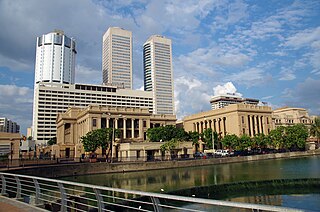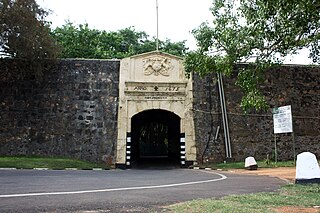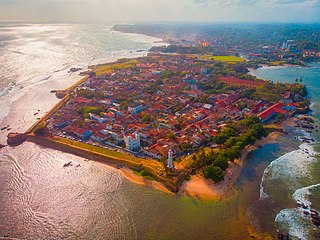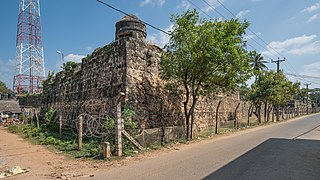
Colombo is the commercial capital and largest city of Sri Lanka by population. According to the Brookings Institution, Colombo metropolitan area has a population of 5.6 million, and 752,993 in the Municipality. It is the financial centre of the island and a tourist destination. It is located on the west coast of the island and adjacent to the Greater Colombo area which includes Sri Jayawardenepura Kotte, the legislative capital of Sri Lanka and Dehiwala-Mount Lavinia. Colombo is often referred to as the capital since Sri Jayawardenepura Kotte is itself within the urban/suburban area of Colombo. It is also the administrative capital of the Western Province and the district capital of Colombo District. Colombo is a busy and vibrant city with a mixture of modern life, colonial buildings and monuments.

Fort Fredrick, also known as Trincomalee Fort or Fort of Triquillimale, is a fort built by the Portuguese at Trincomalee, Eastern Province, Sri Lanka, completed in 1624 CE, built on Swami Rock-Konamamalai from the debris of the world-famous ancient Hindu Koneswaram temple. The temple was destroyed by the Portuguese colonial Constantino de Sá de Noronha under Phillip III, occupier of the Jaffna kingdom and Malabar country on the island. On the Konamalai cape was also built a new village of Portuguese and Tamil people, 50 Portuguese soldiers and inside the fort, a church named after "Nossa Senhora de Guadalupe". The Fort of Triquillimale was dismantled and rebuilt by the Dutch in 1665, renamed Fort Fredrick.

Matara is a major city in Sri Lanka, on the southern coast of Southern Province. It is the second largest city in Southern Province. It is 160 km (99 mi) from Colombo. It is a major commercial hub, and it is the administrative capital and largest city of Matara District.

Negombo is a major city in Sri Lanka, situated on the west coast and at the mouth of the Negombo Lagoon, in Western Province, 38 km from Colombo via Colombo - Katunayake Expressway.

The Treaty of Batticaloa was signed on 14 February 1766 between Dutch Ceylon governor Wilhelm Falk and King Keerthisiri Rajasinghe of Kandy. In Colombo, Dumbararala led five emissaries to negotiate the terms of the treaty. Eventually, twenty-five clauses were established in the agreement.

The Kingdom of Kandy was a monarchy on the island of Sri Lanka, located in the central and eastern portion of the island. It was founded in the late 15th century and endured until the early 19th century.

Anglican and other Protestant missionaries arrived at Sri Lanka during the early 19th century, when the British took control of Sri Lanka from the Dutch. The oldest Protestant church in Sri Lanka is the Christian Reformed Church in Sri Lanka, formerly the Dutch Reformed Church in Sri Lanka, has over 30 congregations and more than 5,000 members.

Forts and fortifications in Sri Lanka date back thousands of years with many being built by Sri Lankan Kings, these include several walled cities. With the out set of colonial rule in the Indian Ocean, Sri Lanka was occupied by several major colonial empires that from time-to-time became the dominant power in the Indian Ocean. The colonists built several western styled forts, mostly in and round the coast of the island. The first to build colonial forts in Sri Lanka were the Portuguese, these forts were captured and later expanded by the Dutch. The British occupied these Dutch forts during the Napoleonic wars.

The Church of Ceylon is the Anglican Church in Sri Lanka. It is an extra-provincial jurisdiction of the Archbishop of Canterbury, who serves as its Metropolitan. It was established in 1845 with the appointment of the first Anglican Bishop of Colombo, James Chapman and until 1950 it consisted of a single diocese; in that year a second diocese was established at Kurunegala.

The Kingdom of Sitawaka was a kingdom located in south-central Sri Lanka. It emerged from the division of the Kingdom of Kotte following the Spoiling of Vijayabahu in 1521. Over the course of the next seventy years it came to dominate much of the island. Sitawaka also offered fierce resistance to the Portuguese, who had arrived on the island in 1505. Despite its military successes, Sitawaka remained unstable, having to contend with repeated uprisings in its restive Kandyan territories, as well as a wide-ranging and often devastating conflict with the Portuguese. Sitawaka disintegrated soon after the death of its last king Rajasimha I in 1593.

Dom Jerónimo de Azevedo was a Portuguese fidalgo, Governor (captain-general) of Portuguese Ceylon and viceroy of Portuguese India.

Galle Fort, in the Bay of Galle on the southwest coast of Sri Lanka, was built first in 1588 by the Portuguese, then extensively fortified by the Dutch during the 17th century from 1649 onwards. It is a historical, archaeological and architectural heritage monument, which even after more than 432 years maintains a polished appearance, due to extensive reconstruction work done by Archaeological Department of Sri Lanka.

The Christian Reformed Church of Sri Lanka is the oldest Protestant church on the island.

The Sinhalese–Portuguese War was a series of conflicts waged from 1527 to 1658 in Sri Lanka between the native Sinhalese kingdoms against the Portuguese Empire. It spanned from the Transitional to the Kandyan periods of Sri Lankan history. A combination of political and military moves gained the Portuguese control over most of the island, but their invasion of the final independent kingdom was a disaster, leading to a stalemate in the wider war and a truce from 1621. In 1638 the war restarted when the Dutch East India Company intervened in the conflict, initially as an ally of the Sinhalese against the Portuguese, but later as an enemy of both sides. The war concluded in 1658, with the Dutch in control of about half the island, the Kingdom of Kandy the other half, and the Portuguese expelled.

Wolvendaal Church is located in Pettah, a neighbourhood of Colombo. It is one of the most important Dutch Colonial era buildings in Sri Lanka, and is one of the oldest Protestant churches still in use in the country.

The Dutch Reformed Church is located within the Matara fort in Matara and is situated near the entrance to the fort. The church was built by the Dutch in 1706 and is a smaller version of the church in Galle fort. It is one of the oldest Protestant churches still in use in the country.

The Groote Kerk or Dutch Reformed Church is located within the Galle fort in Galle, Sri Lanka and is situated near the entrance to the fort. The church was built by the Dutch in 1755 and is one of the oldest Protestant churches still in use in the country.

Kalpitiya Fort was built by the Dutch between 1667 and 1676. Kalpitiya was important as it commands the entrance to the adjacent bay, Puttalam Lagoon. The surrounding Puttalam area was one of the major cinnamon cultivation areas in Sri Lanka. The Dutch even constructed a canal from Puttalam via Negombo to Colombo to transport cinnamon from the area.

St. Thomas' Church is situated in Kotahena a suburb of Colombo, Sri Lanka. It is one of the oldest churches in Sri Lanka as now part of the Anglican Church of Ceylon.




















